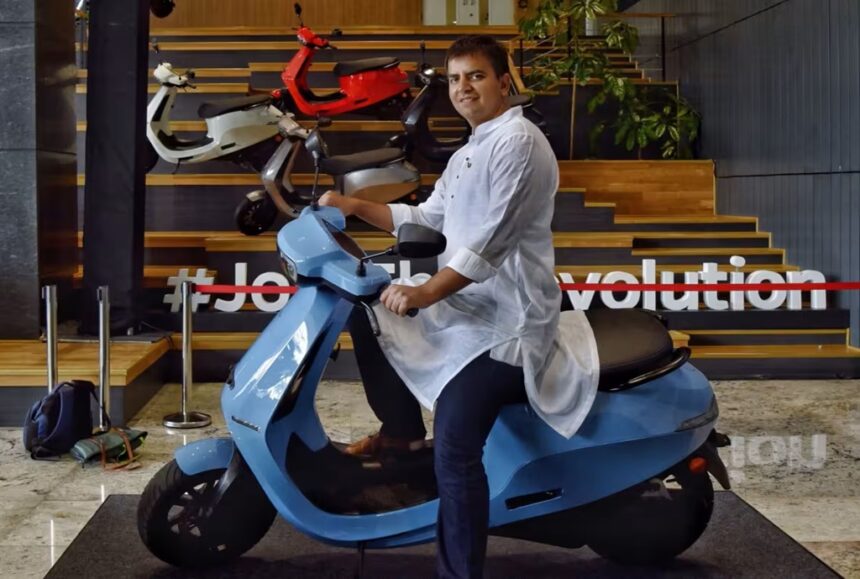MUMBAI – Ola Electric Mobility, once seen as the leader in India’s electric scooter market, is now facing serious challenges. The company, led by CEO Bhavish Aggarwal, is under pressure as it deals with heavy losses, tighter regulations, and tough competition.
Its share in the market has dropped, its stock has lost value, and its financial health is in decline, raising doubts about Ola Electric’s future.
For the March quarter, Ola Electric reported a net loss of ₹870 crore, more than twice the ₹416 crore loss from the same period last year. Revenue from operations dropped 61.8% year-on-year to ₹611 crore, down from ₹1,598 crore, mostly due to weaker sales of its electric scooters.
In the previous quarter, the company posted a ₹564 crore loss with revenue falling 19.36% to ₹1,045 crore. Auditors have flagged concerns about Ola Electric’s ability to stay in business, which is unusual for a listed company.
Ola Electric’sInvestors Spooked
Ola Electric’s difficulties extend beyond financial struggles. Once holding a 30% market share in FY25, the company is now third behind Bajaj Auto and TVS Motor. VAHAN data shows Ola registered just 23,430 scooters in March 2025, while Bajaj took the lead with its Chetak model.
TVS Motor has also moved ahead, using its large network of over 500 dealerships to boost sales, leaving Ola’s 800 showrooms behind. Ather Energy, a competitor from Bengaluru, outsold Ola in February, delivering 11,994 scooters compared to Ola’s 8,600.
Aggarwal’s bold growth plans, which helped Ola raise $4 billion in its August 2024 IPO, have not paid off. The share price has dropped to ₹56.70, 25% below the IPO price of ₹76 and down 60% from a high of ₹157.40.
Investors have been spooked by operational issues, including a mismatch in reported sales numbers. While Ola claimed to have sold 25,000 scooters in February 2025, VAHAN recorded only 8,600 registrations, leading to questions from the Ministry of Heavy Industries and the Ministry of Road Transport and Highways. Ola blamed this gap on a registration backlog tied to new agency agreements, but doubts remain.
The Securities and Exchange Board of India (SEBI) is also investigating Ola for suspected insider trading between October and December 2024 and has issued a warning over a disclosure breach after Aggarwal announced showroom openings on social media before informing the stock exchange.
Ola’s missed targets
The Central Consumer Protection Authority (CCPA) has opened inquiries into more than 10,000 customer complaints since 2023, covering poor after-sales service, misleading adverts, and safety concerns like scooter fires and broken suspensions. One incident even led to a man in Karnataka being arrested for setting fire to an Ola showroom during a dispute over service.
Despite these setbacks, Aggarwal continues to promote new launches, including the Roadster X electric motorbike and third-generation scooters, as the company’s next growth drivers. However, delays in deliveries and slow progress on its planned lithium-ion battery gigafactory, which was expected in early 2025-26, have dented confidence.
Ola Electric’s missed targets under the government’s Production Linked Incentive (PLI) scheme have added to investor unease.
Aggarwal has a history of shaking up India’s mobility market with Ola Cabs, but the electric scooter sector is proving less forgiving. Bajaj and TVS enjoy strong brand loyalty and broad service networks, while Ather’s focus on quality has helped it win customers in cities.
Ola Electric recently let go of 1,000 workers and has been offering deep discounts, which many see as signs of distress rather than a clear plan. Without fixing issues in service, compliance, and financial management, Ola Electric risks falling behind as India’s electric vehicle market grows. Investors and analysts are watching Aggarwal closely, but both time and funding are running short.
Related News:
Google Takes on Apple with Direct Sales and Retail Expansion in India













